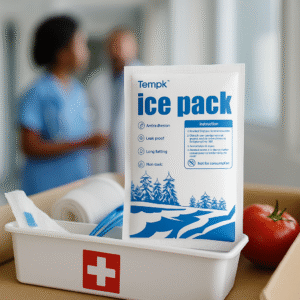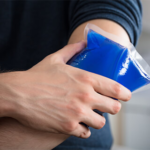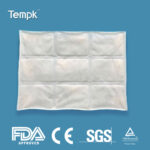How to Use Dry Ice Packs for First Aid: A 2025 Safety Guide
Dry ice packs are revolutionizing first aid treatments, offering faster relief for pain and swelling compared to traditional ice. With advancements in cooling technology, these packs provide targeted cold therapy without the mess of melting ice. Whether you’re treating a sprain, bruise, or heat exhaustion, dry ice packs can be an essential part of your first aid kit. This comprehensive guide covers everything you need to know about using dry ice for first aid, including safety precautions, benefits, and 2025 trends.

Why Choose Dry Ice Pack First Aid?
Dry ice packs offer a cooling temperature of -78.5°C, which provides deeper and faster relief than regular ice packs. This intense cold helps to constrict blood vessels, reduce swelling, and numb pain quickly. In fact, studies have shown that dry ice reduces swelling up to 45% faster than traditional ice within the first 30 minutes of an injury.
Key Benefits of Dry Ice Pack First Aid
| Benefit | Dry Ice Pack First Aid | Traditional Ice Packs | Heat Packs |
|---|---|---|---|
| Cooling Temperature | -78.5°C | 0°C | 40-50°C |
| Time to Numb Pain | 5-10 minutes | 10-15 minutes | N/A |
| Risk of Burns/Skin Damage | Low (if used correctly) | Medium | High |
| Duration of Effect | 10-15 minutes | 20-30 minutes | 20-30 minutes |
| Ideal for Swelling | Yes | Yes | No |
How to Properly Use Dry Ice Packs for First Aid
Using dry ice correctly is essential to avoid frostbite or skin damage. Here’s how to apply it safely:
-
Wrap the Dry Ice Pack: Always wrap the pack in a thick cloth or towel before applying it to the skin. Never apply it directly to the skin to avoid frostbite.
-
Apply for 10-15 Minutes: Limit each application to 10-15 minutes to prevent cold burns.
-
Take Breaks: After each session, let the area warm up at room temperature for at least 30 minutes before reapplying.
-
Monitor for Discomfort: Check the skin regularly for signs of frostbite, such as paleness or numbness.
Dry Ice Pack First Aid Dos and Don’ts
Do:
-
Always use a cloth barrier between the dry ice and the skin.
-
Use a timer to avoid exceeding safe exposure times.
Don’t:
-
Apply dry ice to large areas of the body.
-
Use dry ice if you have poor circulation or compromised skin (e.g., diabetes).
Pro Tip: Consider using a dry ice first aid kit with an insulated bag, temperature monitor, and timer for enhanced safety.
How Does Dry Ice Compare to Regular Ice for Swelling and Pain Relief?
Dry ice packs provide faster, deeper cooling than regular ice packs. Here’s how they compare:
| Cooling Method | Temperature | Time to Numb Pain | Duration of Cooling |
|---|---|---|---|
| Dry Ice Pack | -78.5°C | 5-10 minutes | 10-15 minutes |
| Ice Pack | 0°C | 10-15 minutes | 20-30 minutes |
Dry ice’s lower temperature allows it to penetrate deeper into the skin, offering quicker pain relief and swelling reduction. Traditional ice, on the other hand, works slower and often melts into water, which can dilute the cooling effect.
2025 Trends in Dry Ice First Aid Solutions
Advancements in 2025 are making dry ice packs more effective and user-friendly. Here’s a glimpse at the upcoming trends:
-
Self-Sealing Pouches: New pouches allow for safe handling and storage, minimizing the risk of direct contact with dry ice.
-
Smart Cooling Pads: These innovative pads automatically regulate cooling based on real-time temperature feedback, enhancing safety.
-
Temperature-Controlled Bags: These bags ensure dry ice maintains an optimal temperature longer, preventing rapid sublimation.
These improvements ensure that dry ice first aid solutions are safer, more efficient, and more accessible than ever before.
Frequently Asked Questions about Dry Ice Pack First Aid
Q1: Can I use a dry ice pack for muscle sprains?
Yes, dry ice packs are ideal for treating muscle sprains. Just ensure the pack is wrapped in cloth to avoid skin damage.
Q2: How often can I apply a dry ice pack for pain relief?
You can apply the pack every hour, ensuring you give the skin time to warm up between uses to avoid cold burns.
Q3: Are there any risks to using dry ice for first aid?
Yes, frostbite and CO₂ poisoning are the primary risks. Always use a cloth barrier, limit exposure time, and ensure proper ventilation.
Q4: How long can dry ice stay cold for first aid?
A dry ice pack remains effective for about 10-15 minutes, depending on the insulation and environment.
Conclusion: Dry Ice Pack First Aid for Faster Recovery
Dry ice packs are a powerful tool for reducing pain, swelling, and inflammation in injuries. By following safety guidelines and applying the pack in short bursts, you can ensure faster recovery. Stay updated on the latest advancements in dry ice first aid products to maximize their effectiveness and safety.
Action Plan
-
Choose the Right Dry Ice Pack: Look for packs with proper insulation and safety features.
-
Use in Controlled Bursts: Apply for 10-15 minutes per session, with breaks in between.
-
Stay Informed: Keep up with innovations in dry ice first aid for improved performance and safety.
About Tempk
At Tempk, we specialize in providing innovative temperature-controlled solutions for a range of industries. Our dry ice first aid packs offer fast and effective relief, designed with safety in mind. With ongoing product innovations and a commitment to sustainability, Tempk is here to support you in every emergency situation.
Need expert guidance? Contact Tempk for a free consultation on first aid solutions tailored to your needs.























